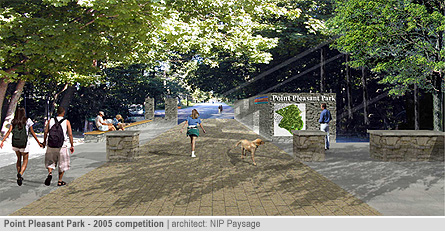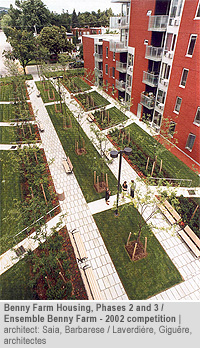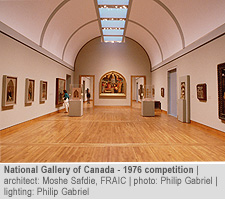Sponsor (also known as Client)
The sponsor has the most important role in an architectural competition. He/she initiates the competition and provides the funding that pays for the expenses of the competition.
 Sponsors expect a well-run competition with a high level of participation resulting in a creative outcome that meets their objectives. As well, a sponsor may want to raise public interest in the project.
Sponsors expect a well-run competition with a high level of participation resulting in a creative outcome that meets their objectives. As well, a sponsor may want to raise public interest in the project.
Sponsor’s General Responsibilities
-
Ensure fairness to all parties.
-
Set clear objectives and requirements.
-
Identifies and adheres to criteria for selecting a winner.
-
In an endorsed competition, commits to the award of a commission to the winning architect.
-
In a non-endorsed competition, should commit to paying competitors for their time and effort.
Sponsor’s Specific Responsibilities
A sponsor has different responsibilities, depending on the type of competition.
Professional Advisor
A professional advisor is required to help a sponsor run an endorsed architectural competition and is highly recommended for a sponsor of a non-endorsed design competition.
Finding a professional advisor: The RAIC or the relevant provincial/territorial architectural associations of architects can help sponsors find experienced architects to serve as professional advisors.
Payment: A professional advisor is paid at least an amount equal to the prevailing hourly rate for consultation work as recommended the tariff of fees of the relevant provincial or territorial architectural association. Where there is no tariff of fees the professional advisor shall receive a per diem rate equivalent to senior professionals in the region. As well, all disbursements or out-of pocket expenses are reimbursed.
Qualifications for a Professional Advisor
-
Is registered or licensed to practice architecture in one or more Canadian provinces or territories.
-
Has no financial or vested interest in the competition.
-
Has technical knowledge of the competition process through previous experience as a competitor, advisor, juror, or through attending a workshop sponsored by a professional association or the RAIC.
-
Is sensitive to sponsor’s goals.
-
Is committed to the competition process for the project in question.
-
Is able to translate sponsor’s needs into the appropriate competition procedures.
Professional Advisor’s Responsibilities
The following sections have been written for endorsed competitions. However, sponsors administering non-endorsed competitions can adapt these responsibilities to their own specific situations.
1) Pre-Competition
-
Ensures that both sponsor’s and competitors’ interests are safeguarded with regard to competition rules.
-
Is satisfied that sponsor has appropriate authority and financial resources to carry out the competition.
-
Suggests hiring of technical committee if project is technically or financially complex, and the jury will require additional help.
-
Advises sponsor on the number of competitors and method of selecting finalists in a limited competition.
-
Assists the sponsor in determining a fair and equal honorarium/prize for each entrant, or the amount and number of awards and prizes.
-
Assists the sponsor, as necessary, in developing a competition brief. This document outlines all instructions for participating in a competition, including the functional program
-
Prepares competition documents containing the submission requirements and all relevant information required to prepare a design such as surveys, context, photos, history, background, program, goals, objectives, and key design issues.
-
Assists the sponsor in developing appropriate competition rules.
-
Ensures all competitors are placed under uniform conditions throughout the competition process such as submission requirements, mandatory information, and terms of disqualification.
-
Creates a schedule for competitors.
-
Assists in the selection of a jury, if applicable, and in planning competition logistics such as schedule and location for jury deliberations.
-
Submits draft conditions to the relevant provincial/territorial association of architects or the RAIC for approval and allows adequate time for this approval process. Ensures the final document is consistent with this approval.
2) During Competition Registration
-
Arranges promotion and advertisement of competition and makes registration forms available.
-
Arranges for competition conditions to be published appropriately in English and/or French, and indicate one as the legal document and the other a translation.
-
Checks competitors’ names for eligibility in the competition immediately at the close of registration.
-
Arranges for questions and answers to be published appropriately and distributed promptly in English and/or French, indicating one as the legal document and the other a translation.
-
Acknowledges receipt of all submissions on behalf of sponsor.
-
Examines submissions to ensure they comply with mandatory conditions.
-
Rejects non-compliant submissions and notifies rejected competitors in writing.
-
Draws up a checklist of mandatory requirements. Attaches a copy with his/her signature to each prize-worthy submission. The certified checklist will be displayed with the designs if the competition includes awards and honorable mentions.
3) During and After the Competition
-
Ensures that anonymity of entries is maintained throughout the competition.
-
Assists jury and instructs it with regard to procedures.
-
Reviews jury’s decision to ensure it complies with the competition conditions. If it does not, returns decision to jury, requesting a judgment that does comply.
-
Provides sponsor with competition results in writing.
-
Assists sponsor in notifying competitors and the media.
-
Takes all reasonable steps to ensure materials are returned to competitors promptly if such a commitment was made in the competition documents. However, if a public exhibition of submissions is stated in the conditions, material may be retained for a limited time for this purpose.
-
Prepares a report, for jury approval, which:
-
Lists all winners
-
Demonstrates to competitors, the public, and other stakeholders that the process was fair and reasonable
-
May make recommendations to the sponsor on improvements or further studies suggested for the winning design
-
Provides constructive criticism for all submissions.
-
Endeavours to have sponsor promptly pay all awards to competitors and all fees associated with the competition.
Jury
The jury for an architectural competition is a group of individuals and architects assembled to evaluate competitors’ submissions, select a winning design based on the competition criteria, and choose other award winners, if required.
Payment: The sponsor is expected to cover the time and expenses of jurors, including travel, meals, and other costs. Normally, the fee for a jury member will approximate the per diem rate for a senior professional in the area where the competition is being held; however, honoraria for jury members is sometimes negotiated.
Selection of Jurors
Jurors are selected:
-
By the professional advisor in consultation with the appropriate provincial or territorial associations of architects or the RAIC and then recommended to the sponsor.
-
Based on their experience, reputation, and credibility as experts in their field, their ability to work in a challenging situation, and their communication skills (see Composition of the Jury below).
-
Before the formal announcement of the competition.
Composition of the Jury
Jury membership, including a brief resume of each member, will be included in the competition program. Architects who are considering entering the competition will base their decision to compete, in part, on the makeup of the jury.
Number of jurors: A jury should be made up of enough members to give the jury breadth of experience and a variety of opinion, but also be small enough to function effectively.
-
The number can vary according to the type, size, and complexity of the project.
-
Juries usually range from three to seven members.
-
The jury should have an odd number of jurors to avoid a tie vote.
Category of competition: A jury for an endorsed competition must be composed of a majority of architects. The same ratio is recommended for a non-endorsed competition.
 Architects selected to serve on a jury should:
Architects selected to serve on a jury should:
-
Be registered architects.
-
Be widely recognized and credible.
-
Have no current relationship with any of the competitors. (Although this can be difficult, every effort should be made to find jurors with no relationships that could influence their decisions.)
-
Be capable of expressing their opinions clearly.
-
Be capable of working with others to reach an agreement in a relatively short period of time.
Other persons selected to serve on a jury should:
-
Be involved in an interested group such as local government or citizen’s groups, or be knowledgeable in the building type.
-
Be credible and recognized in their field.
-
Have no current or future relationship with any of the competitors.
-
Be capable of expressing their opinions clearly.
-
Be capable of working with others to reach an agreement in a relatively short period of time.
Jury’s Activities and Responsibilities
1) General
The jurors must understand and accept the competition requirements and objectives in advance of agreeing to become a juror. Minor concerns should be worked out with the professional advisor prior to the competition. If a prospective juror has serious concerns which cannot be resolved then he or she should not become a juror. As well, jurors should:
-
Treat the competition program as a contract binding upon them in their selection process;
-
Allot adequate time prior to the jury process to review pertinent documents, to visit the site if applicable, and to take part in any other activities that may be part of their role;
-
Select a jury Chair, from among the members, if not selected previously by the professional advisor and sponsor.
-
Analyze and evaluate competition submissions in accordance with the competition criteria, recognizing that it is not reasonable to the sponsor or competitors to change requirements.
-
Review and formally approve the report prepared by the Professional Advisor on the competition which:
-
Lists all winners;
-
Demonstrates to competitors, the public, and other stakeholders that the process was fair and reasonable;
-
Makes recommendations to the sponsor on improvements or further studies suggested for the winning design;
-
Provides constructive criticism for all submissions.
-
Maintain confidentiality as defined within their agreement with the sponsor.
2) Pre-Evaluation
Jurors should:
-
Review and confirm agreement with the terms of the competition.
-
Become knowledgeable with competition documents, site, and other pertinent information.
-
If required, meet and select Chair, and agree with process to be followed during evaluation.
3) Evaluation of Submissions
Juries use a variety of ways of evaluating submissions, and choice also depends on the type of competition. In general, jurors should:
-
Gain an overview of all submissions, exchange views, and then sort submissions into categories such as “superior,” “worthy of further consideration,” and “insufficient quality.”
-
Sort submissions by consensus or voting. In either case, notes must be kept for accurate inclusion in the final report.
If the competition is a one-stage process, the jury only meets once for the evaluation of submissions.
If the competition is a two-stage process:
-
First stage: The jury reviews submissions to establish a short list of participants for the second stage. The selection is based on a limited design submission, such as concept design. Those architects whose submissions are selected are invited to participate in the second stage.
-
Second stage: The jury selects a winner from the design submissions of the architects selected to participate in the second stage.
If none of the submissions are judged as worthy: Jurors may be empowered by the competition program to recommend that no first prize be awarded. In this case, the jurors should provide their observations on why the competition process failed to result in a winning design.
Technical Committee
A sponsor may hire an individual or a committee to assess either the competition or the submissions for a project, whether endorsed or non-endorsed, if the technical or budgetary requirements are unusual or complex.
Payment: Committee members are paid at least an amount equal to the prevailing hourly rate for consultation work as recommended in the tariff of fees of the relevant provincial or territorial associations of architects. Their disbursements and out-of-pocket expenses are also reimbursed.
Function of the Technical Committee
The technical committee has two functions. It may:
-
Assist the professional advisor in the staging of the competition with regards to technical or budgetary requirements.
-
Consult directly with the jury in order to help jury members assess technical or budgetary elements of the proposals.
Qualifications of Committee Members
Members of the technical committee should have technical expertise that is specific to the functional program, and they should complement the expertise of the professional advisor. They must also be independent from the competition in all respects. Therefore, they are:
-
Not members of the jury.
-
Not employed by the sponsor.
-
Not affiliated with any competitors.
Competitors
While the primary purpose of a design competition is to find the optimal solution to a particular building or other opportunity, competitions help members of the architectural profession become more knowledgeable about ideas and talent.
 Benefits for Competitors
Benefits for Competitors
-
Prize-winning architects gain public and professional recognition.
-
Emerging and established architects find the challenge of competing with some of the best architects in the nation or world a stimulant to their own work.
-
Competitions elevate the level of public expectation regarding architectural design. Such heightened awareness challenges the profession to offer its best, thus stimulating an improvement in architectural design, generally. All architects who participate in competitions contribute to this purpose, regardless of whether or not they win.
The Public
Many members of the public have an interest in architecture, ranging from an interest in beauty to issues of sustainability and “green architecture.” Well-run architectural competitions elevate the level of public expectation regarding architectural design and and its importance for communities and the environment.
Thus, the purpose of competitions, in general, is to raise public awareness of projects. In the case of government buildings, sponsors often stage competitions so that taxpayers can better understand how their money is being spent.
Involving the Public
Recent competitions have demonstrated the benefits of directly involving the public in the competition process. For example, members of the public were invited to vote for their preferred design for the Vancouver Library competition. This ability to “have a say” generated a great deal of public enthusiasm and excitement.
Another method of involving the public is through exhibits and websites. The public can be invited to view design proposals and make comments which will be available to the jury for its consideration.
Following a competition it is very common to arrange for an exhibition of all submissions. Such an exhibition can contribute to public debate and a better understanding of architecture and its importance to the community.

 Sponsors expect a well-run competition with a high level of participation resulting in a creative outcome that meets their objectives. As well, a sponsor may want to raise
Sponsors expect a well-run competition with a high level of participation resulting in a creative outcome that meets their objectives. As well, a sponsor may want to raise  Architects selected to serve on a jury should:
Architects selected to serve on a jury should: Benefits for Competitors
Benefits for Competitors